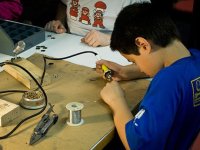6 Strategies for Funding a Makerspace
Your content has been saved!
Go to My Saved Content.The Maker movement continues to gain momentum. At this year's White House Science Fair, President Obama invited Super-Awesome Sylvia from Auburn, California to exhibit her water color robot as a representative of the Maker community. At the same event, the Corporation for National Service announced its commitment to place Americorps VISTAs in Maker movement organizations across the country. Maker Ed is placing those Maker VISTAs in makerspaces to help build their capacity for engaging low-income students as makers. In this spirit, we are starting to see more and more makerspaces springing up in schools across the country. If you are a teacher experimenting with making projects in your classroom, here are some successful fundraising strategies we've seen educators use to fund a makerspace for their school community.
1. Find or Repurpose a Space
Finding a room is easier than you think. Many cities and school districts have underutilized or forgotten spaces that can be repurposed for a very low cost. For example, Andrew Coy, high school technology teacher and Executive Director of the Digital Harbor Foundation, established Baltimore City's first free, public, neighborhood makerspace in an empty Parks & Recreation building that was about to be shut down. Andrew explains, "Elementary principals I talked to about making also had ideas for how the spaces next to their buildings could be used . . . turning one of them over to us for all maker programming. Although this whole process took almost an entire year, was full of moments of delay or doubt, and was not without mistakes, the end result was well worth the effort and has made for a great partnership."
Likewise, high school math teacher Casey Shea walked his maker class off campus in Sebastopol, California. In the second year, he convinced his school administration to let him clean out a storage facility only to find that the old woodshop was buried underneath. Students uncovered old tools and machinery, built the furniture and designed the space. Math classes are held in the makerspace all day.
Rick Shertle, middle school teacher and founder of the Washington Maker Workshop in San Jose, California recently opened his doors to the community by securing a space from a local church for free. The space is within walking distance of several schools.
2. Start a Maker Club
Start a maker club to raise money for the project, engaging the campus and local community. Conduct a "tool drive" within your school or neighborhood, asking parents to donate tools. You wouldn't believe how many extra tools people have in storage. While we'd like families to save some tools for making things together at home, many would be happy to donate their extra tools to schools.
Many teachers and students may try school club fundraising strategies on campus, such as hosting a "make-a-thon" or another type of "a-thon" (i.e., a pedal-a-thon with bicycle hacks). At Pittsburg High School in Contra Costa County, California, the math and woodshop classes sell what they make. Past fundraisers included 3D-printed cell phone cases or engraved student mementos using their laser cutter.
Search for civic organizations, societies and religious groups to bring the community into what the students are making in the schools. The local Rotary Club may not have heard of the Maker movement, but why not bring a mini Maker Faire to them? Maker clubs and teachers can showcase student work at a local Rotary meeting. This strategy worked for Casey Shea.
3. Apply for Company Sponsorships
- PG&E Bright Ideas: This is a great opportunity for getting alternative energy related materials. For example, Pacific Gas & Electric (PG&E) funded a truck conversion and solar powered scooter last year at Oakland's Lighthouse Charter School. At another school, a teacher funded an alternative energy fair where students built their own wind turbines, biofuel generators, etc. with this award.
- Botball Robotics sponsorships: Some teachers seek team funding from sources like Botball, which offers a scholarship.
- ING Unsung Heroes: Each year, 100 educators are selected to receive $2,000 to help fund their innovative class projects. Three of those are chosen to receive the top awards of an additional $5,000, $10,000 and $25,000.
- Lowes Toolbox for Education: This is another opportunity that many teachers have used. Raise $5,000 in minutes from Lowe's Charitable and Educational Foundation, which will help your parent-teacher group achieve even more for your school.
4. Seek Grants
Schools can secure a grant from their state's Department of Education or local funders. Aaron Vanderwerff at Lighthouse Charter School is now on release time from the classroom to serve as a "maker coordinator" supporting K-12 teachers. He will use the makerspace to coach others throughout the East Bay area.
Grant funding is often an issue for those who don't have nonprofit status, so you may need to seek an organization to represent you, such as Tides Center. Fiscal sponsorship is a cost-effective way to implement new programs, bring together groups to collaborate on an issue, and test new approaches to social change.
5. Fund Project Materials Online
Teachers will often use DonorsChoose.org for project materials. DonorsChoose lets teachers share their classroom needs with a thriving community eager to help. We suggest using this tool to raise money for materials to be used during Spring semester, building in time for up to four months of posting projects, planning, and receiving supplies.
6. Start a Campaign
Indiegogo is a crowdfunding platform where people who want to raise money can create fundraising campaigns to tell their story and get the word out. You can design your own campaign around your new makerspace.
A makerspace is a learning environment rich with possibilities. Makerspaces come in all shapes and sizes and serve as a gathering point for tools, projects, mentors and expertise. MAKE: Magazine says a collection of tools does not define a makerspace. Rather, it is defined by what it enables: making.
